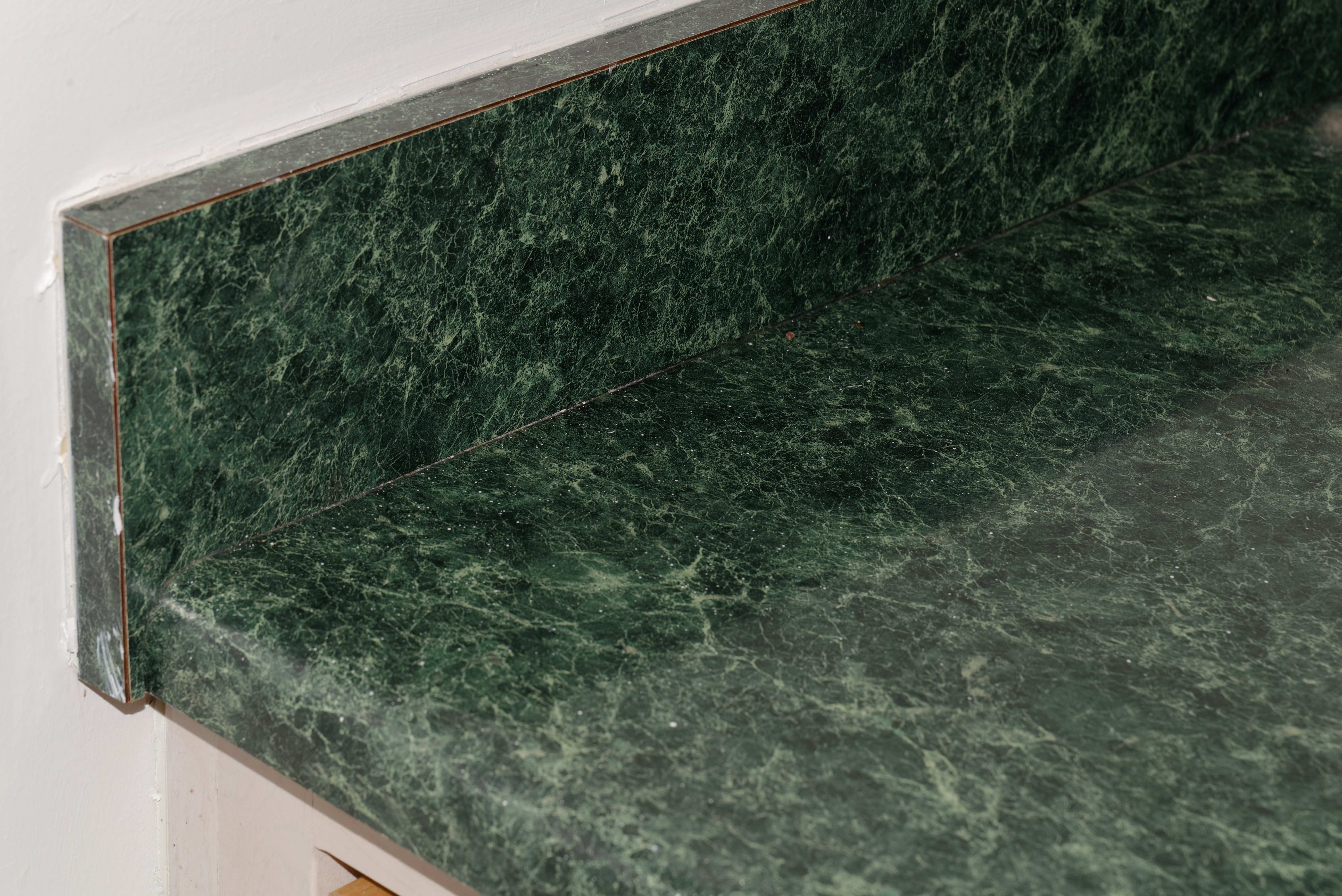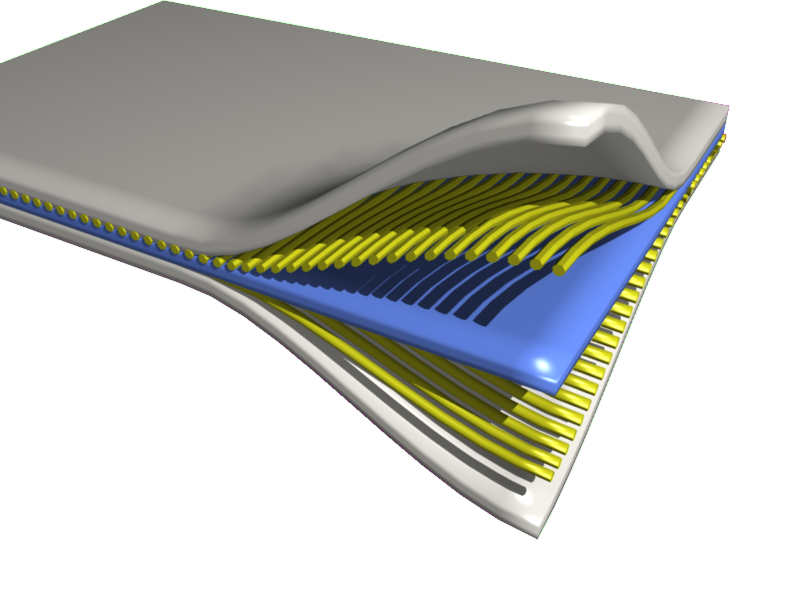|
SRBP
FR-2 (Flame Resistant 2) is a NEMA designation for synthetic resin bonded paper, a composite material made of paper impregnated with a plasticized phenol formaldehyde resin, used in the manufacture of printed circuit boards. Its main properties are similar to NEMA grade XXXP (MIL-P-3115) material, and can be substituted for the latter in many applications. Applications FR-2 sheet with copper foil lamination on one or both sides is widely used to build low-end consumer electronic equipment. While its electrical and mechanical properties are inferior to those of epoxy-bonded fiberglass, FR-4, it is significantly cheaper. It is not suitable for devices installed in vehicles, as continuous vibration can make cracks propagate, causing hairline fractures in copper circuit traces. Without copper foil lamination, FR-2 is sometimes used for simple structural shapes and electrical insulation. Properties Fabrication FR-2 can be machined by drilling, sawing, milling and hot punchin ... [...More Info...] [...Related Items...] OR: [Wikipedia] [Google] [Baidu] |
National Electrical Manufacturers Association
The National Electrical Manufacturers Association (NEMA) is the largest trade association of electrical equipment manufacturers in the United States. Founded in 1926, it advocates for the industry, and publishes standards for electrical products. Notably, the form of US household electrical outlets and plugs is specified by NEMA. Description It was founded in 1926 and maintains its headquarters in Rosslyn, Virginia, in the Washington metropolitan area. Its approximately 350 member companies manufacture products used in the generation, transmission, distribution, control, and end use of electricity. These products are used in utility, industrial, commercial, institutional, and residential applications. The association's Medical Imaging and Technology Alliance (MITA) division represents manufacturers of cutting-edge medical diagnostic imaging equipment including MRI, CT, x-ray, and ultrasound products. Other major end markets include building systems, electrical infrastructure ... [...More Info...] [...Related Items...] OR: [Wikipedia] [Google] [Baidu] |
Volt
The volt (symbol: V) is the unit of electric potential, electric potential difference (voltage), and electromotive force in the International System of Units (SI). It is named after the Italian physicist Alessandro Volta (1745–1827). Definition One volt is defined as the electric potential between two points of a conducting wire when an electric current of one ampere dissipates one watt of power between those points. Equivalently, it is the potential difference between two points that will impart one joule of energy per coulomb of charge that passes through it. It can be expressed in terms of SI base units ( m, kg, second, s, and ampere, A) as : \text = \frac = \frac = \frac. It can also be expressed as amperes times ohms (current times resistance, Ohm's law), webers per second (magnetic flux per time), watts per ampere (power per current), or joules per coulomb (energy per charge), which is also equivalent to electronvolts per elementary charge: : \text = \tex ... [...More Info...] [...Related Items...] OR: [Wikipedia] [Google] [Baidu] |
Composite Materials
A composite material (also called a composition material or shortened to composite, which is the common name) is a material which is produced from two or more constituent materials. These constituent materials have notably dissimilar chemical or physical properties and are merged to create a material with properties unlike the individual elements. Within the finished structure, the individual elements remain separate and distinct, distinguishing composites from mixtures and solid solutions. Typical engineered composite materials include: * Reinforced concrete and masonry *Composite wood such as plywood *Reinforced plastics, such as fibre-reinforced polymer or fiberglass *Ceramic matrix composites ( composite ceramic and metal matrices) *Metal matrix composites *and other advanced composite materials There are various reasons where new material can be favoured. Typical examples include materials which are less expensive, lighter, stronger or more durable when compared with com ... [...More Info...] [...Related Items...] OR: [Wikipedia] [Google] [Baidu] |
Micarta
Micarta is a brand name for composites of linen, canvas, paper, fiberglass, carbon fiber, or other fabric in a thermosetting plastic. It was originally used in electrical and decorative applications. Micarta was developed by George Westinghouse at least as early as 1910 using phenolic resins invented by Leo Baekeland. These resins were used to impregnate paper and cotton fabric which were cured under pressure and high temperature to produce laminates. In later years this manufacturing method included the use of fiberglass fabric, and other resin types were also used. Today Micarta high-pressure industrial laminates are produced with a wide variety of resins and fibers. The term has been used generically for most resin impregnated fiber compounds. Common uses of modern high-pressure laminates include electrical insulators, printed circuit board substrates, and knife handles. The Micarta trademark is a registered trademark of Industrial Laminates / Norplex, Inc. (dba Norplex-Micar ... [...More Info...] [...Related Items...] OR: [Wikipedia] [Google] [Baidu] |
Formica (plastic)
Formica Laminate is a laminated composite material invented at the Westinghouse Electric Corporation in the United States in 1912. Originally used to replace mica in electrical applications, it has since been manufactured for multiple applications. It has been produced by Formica Group manufacturing sites across the globe since. Formica Group are best known for the company's classic product: a heat-resistant, wipe-clean laminate of paper or textile with melamine resin. Formica Group, a division of the Dutch company Broadview Holdings, consists of Formica Canada, Inc., Formica Corporation, Formica de Mexico S.A. de C.V., Formica IKI Oy, Formica Limited, Formica S.A., Formica S.A.S., Formica Taiwan Corporation, Formica (Thailand) Co., Ltd., Formica (Asia) Ltd., and others. Etymology The mineral mica was commonly used at that time for electrical insulation. Because the new product acted as a substitute "for mica", Faber used the name ''Formica'' as a trademark. The word alread ... [...More Info...] [...Related Items...] OR: [Wikipedia] [Google] [Baidu] |
Phenolic Paper
Phenolic paper is a material often used to make printed circuit board substrates (the flat board to which the components and traces are attached). It is a very tough board made of wood fibre and phenolic polymers. It is most commonly brown in colour, and is a fibre reinforced plastic. These PCB materials are known as FR-1 and FR-2 FR-2 (Flame Resistant 2) is a NEMA designation for synthetic resin bonded paper, a composite material made of paper impregnated with a plasticized phenol formaldehyde resin, used in the manufacture of printed circuit boards. Its main properties ar ... – FR-2 is rated to 130°C, FR-1 is rated to 105°C. By R.G. Keen, 1999, Website about amateur electronics prototyping References [...More Info...] [...Related Items...] OR: [Wikipedia] [Google] [Baidu] |
Tungsten Carbide
Tungsten carbide (chemical formula: WC) is a chemical compound (specifically, a carbide) containing equal parts of tungsten and carbon atoms. In its most basic form, tungsten carbide is a fine gray powder, but it can be pressed and formed into shapes through sintering for use in industrial machinery, cutting tools, chisels, abrasives, armor-piercing shells and jewelry. Tungsten carbide is approximately twice as stiff as steel, with a Young's modulus of approximately 530–700 GPa, and is double the density of steel—nearly midway between that of lead and gold. It is comparable with corundum (α-) in hardness and can be polished and finished only with abrasives of superior hardness such as cubic boron nitride and diamond powder, wheels and compounds. Naming Historically referred to as Wolfram, ''Wolf Rahm'', wolframite ore was then later carburized and cemented with a binder creating a composite now called "tungsten carbide". Tungsten is Swedish for "heavy stone". Col ... [...More Info...] [...Related Items...] OR: [Wikipedia] [Google] [Baidu] |
Thou (unit Of Length)
A thousandth of an inch is a derived unit of length in a system of units using inches. Equal to of an inch, a thousandth is commonly called a thou (used for both singular and plural) or particularly in North America a mil (plural mils). The words are shortened forms of the English and Latin words for "thousand" ( in Latin). In international engineering contexts, confusion can arise because ''mil'' is a formal unit name in North America but ''mil'' or ''mill'' is also a common colloquial clipped form of millimetre. The units are considerably different: a millimetre is approximately 39 mils. Contexts of use The thou, or mil, is most commonly used in engineering and manufacturing in non-metric countries. For example, in specifying: * The thickness of items such as paper, film, foil, wires, paint coatings, latex gloves, plastic sheeting, and fibers ** For example, most plastic ID cards are about in thickness. ** Card stock thickness in the United States, where mils are also ... [...More Info...] [...Related Items...] OR: [Wikipedia] [Google] [Baidu] |
Dielectric Strength
In physics, the term dielectric strength has the following meanings: *for a pure electrically insulating material, the maximum electric field that the material can withstand under ideal conditions without undergoing electrical breakdown and becoming electrically conductive (i.e. without failure of its insulating properties). *For a specific piece of dielectric material and location of electrodes, the minimum applied electric field (i.e. the applied voltage divided by electrode separation distance) that results in breakdown. This is the concept of breakdown voltage. The theoretical dielectric strength of a material is an intrinsic property of the bulk material, and is independent of the configuration of the material or the electrodes with which the field is applied. This "intrinsic dielectric strength" corresponds to what would be measured using pure materials under ideal laboratory conditions. At breakdown, the electric field frees bound electrons. If the applied electric field is ... [...More Info...] [...Related Items...] OR: [Wikipedia] [Google] [Baidu] |
Composite Material
A composite material (also called a composition material or shortened to composite, which is the common name) is a material which is produced from two or more constituent materials. These constituent materials have notably dissimilar chemical or physical properties and are merged to create a material with properties unlike the individual elements. Within the finished structure, the individual elements remain separate and distinct, distinguishing composites from mixtures and solid solutions. Typical engineered composite materials include: *Reinforced concrete and masonry *Composite wood such as plywood *Reinforced plastics, such as fibre-reinforced polymer or fiberglass *Ceramic matrix composites ( composite ceramic and metal matrices) *Metal matrix composites *and other advanced composite materials There are various reasons where new material can be favoured. Typical examples include materials which are less expensive, lighter, stronger or more durable when compared with commo ... [...More Info...] [...Related Items...] OR: [Wikipedia] [Google] [Baidu] |
Dissipation Factor
In physics, the dissipation factor (DF) is a measure of loss-rate of energy of a mode of oscillation (mechanical, electrical, or electromechanical) in a dissipative system. It is the reciprocal of quality factor, which represents the "quality" or durability of oscillation. Explanation Electrical potential energy is dissipated in all dielectric materials, usually in the form of heat. In a capacitor made of a dielectric placed between conductors, the typical lumped element model includes a lossless ideal capacitor in series with a resistor termed the equivalent series resistance (ESR) as shown below. The ESR represents losses in the capacitor. In a good capacitor the ESR is very small, and in a poor capacitor the ESR is large. However, ESR is sometimes a minimum value to be required. Note that the ESR is ''not'' simply the resistance that would be measured across a capacitor by an ohmmeter. The ESR is a derived quantity with physical origins in both the dielectric's conduction e ... [...More Info...] [...Related Items...] OR: [Wikipedia] [Google] [Baidu] |





